The storm at the top of the world
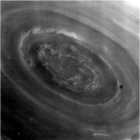 Making a close pass by the north pole of the planet Saturn – roughly the same distance as the average distance between Earth and its moon – NASA’s Cassini space probe captures unprecedented images of a hurricane-like storm vortex at the planet’s pole. With a diameter nearly as wide as the continental United States, the north polar vortex reveals vertical relief of various cloud features for the first time, and spins rapidly at the center of a hexagonal cloud feature nearly twice as wide as Earth itself.
Making a close pass by the north pole of the planet Saturn – roughly the same distance as the average distance between Earth and its moon – NASA’s Cassini space probe captures unprecedented images of a hurricane-like storm vortex at the planet’s pole. With a diameter nearly as wide as the continental United States, the north polar vortex reveals vertical relief of various cloud features for the first time, and spins rapidly at the center of a hexagonal cloud feature nearly twice as wide as Earth itself.
Cassini’s mission extended by two years
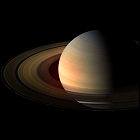 After four years orbiting the enormous ringed planet Saturn and flying past its dozens of moons, NASA’s unmanned Cassini probe still hasn’t seen it all. The four successful years thus far included releasing the European Space Agency’s Huygens probe to make the first ever landing on the large moon Titan, discovering (and flying through) water geysers over another moon, and exploring other moons that have puzzled scientists since they were first viewed up close in the early 1980s by the Voyager probes. The mission extension – called the Cassini Equinox Mission – gives Cassini an added two-year lease of life, with a $160 million price tag (the mission so far has cost both NASA and ESA a combined total of $3.3 billion).
After four years orbiting the enormous ringed planet Saturn and flying past its dozens of moons, NASA’s unmanned Cassini probe still hasn’t seen it all. The four successful years thus far included releasing the European Space Agency’s Huygens probe to make the first ever landing on the large moon Titan, discovering (and flying through) water geysers over another moon, and exploring other moons that have puzzled scientists since they were first viewed up close in the early 1980s by the Voyager probes. The mission extension – called the Cassini Equinox Mission – gives Cassini an added two-year lease of life, with a $160 million price tag (the mission so far has cost both NASA and ESA a combined total of $3.3 billion).
Huygens: first space probe to land on Titan
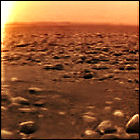 The European Space Agency’s Huygens probe successfully lands on Saturn’s largest moon, Titan, gathering measurements and taking mind-boggling images from the sky all the way down to the surface. Perhaps the biggest discovery of the initial pictures is an aerial view of what appear to be tributaries leading to a large body of liquid – an almost delta-like region as viewed from the sky. (Thanks to Titan’s thick atmospheric haze, its surface has never before been seen.) Huygens itself manages to touch down on dry land, on a plain scattered with chunks of ice, slowed to only 15 miles per hour by parachutes during its descent (despite upper-level winds estimated at around 300mph). Even if Huygens had splashed down in a body of liquid, the probe is designed to stay afloat.
The European Space Agency’s Huygens probe successfully lands on Saturn’s largest moon, Titan, gathering measurements and taking mind-boggling images from the sky all the way down to the surface. Perhaps the biggest discovery of the initial pictures is an aerial view of what appear to be tributaries leading to a large body of liquid – an almost delta-like region as viewed from the sky. (Thanks to Titan’s thick atmospheric haze, its surface has never before been seen.) Huygens itself manages to touch down on dry land, on a plain scattered with chunks of ice, slowed to only 15 miles per hour by parachutes during its descent (despite upper-level winds estimated at around 300mph). Even if Huygens had splashed down in a body of liquid, the probe is designed to stay afloat.
Cassini and the ice volcanoes of Titan!
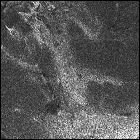 A billion miles from the sun, you don’t need molten lava for volcanoes – you just need subsurface ice to warm up and erupt as water. That’s what NASA scientists think they’ve spotted in a radar image of the surface of Saturn’s moon Titan sent back in late October by the Cassini unmanned probe. A bright, flow-like feature may be indicative of something oozing out onto Titan’s surface from below – and at the frigid temperatures experienced in Saturn’s orbit, ice volcanoes are more likely than the molten rock variety seen on Earth and Mars. If confirmed, this wouldn’t be the first “ice volcano” found in our solar system; Voyager 2 had already spotted an eruption on the surface of Neptune’s largest moon, Triton, as it swung by in August 1989.
A billion miles from the sun, you don’t need molten lava for volcanoes – you just need subsurface ice to warm up and erupt as water. That’s what NASA scientists think they’ve spotted in a radar image of the surface of Saturn’s moon Titan sent back in late October by the Cassini unmanned probe. A bright, flow-like feature may be indicative of something oozing out onto Titan’s surface from below – and at the frigid temperatures experienced in Saturn’s orbit, ice volcanoes are more likely than the molten rock variety seen on Earth and Mars. If confirmed, this wouldn’t be the first “ice volcano” found in our solar system; Voyager 2 had already spotted an eruption on the surface of Neptune’s largest moon, Triton, as it swung by in August 1989.
Cassini peers through Titan’s clouds
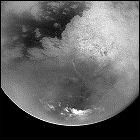 In its first close flyby of Saturn’s largest moon, the unmanned Cassini probe performs the first-ever radar reconaissance of Titan’s surface. Shrouded by a thick, organically-rich atmosphere, Titan’s surface has never been seen until now. Though scientists say that Cassini’s close pass only allows them to map 1% of the surface, the preliminary results prove to be fascinating. Titan seems, at first glance, to have a relatively smooth surface, perhaps indicating oceans, or ongoing glacial or volcanic resurfacing; a member of the radar imaging team says that readings have also indicated that the surface of Titan is “covered in organics.” Cassini will get further chances to aim its radar beams at Titan, and in December it will release the European Space Agency’s Huygens probe, which will approach Titan, ultimately entering the moon’s dense atmosphere in January to take direct readings from the surface, whether it’s solid or liquid.
In its first close flyby of Saturn’s largest moon, the unmanned Cassini probe performs the first-ever radar reconaissance of Titan’s surface. Shrouded by a thick, organically-rich atmosphere, Titan’s surface has never been seen until now. Though scientists say that Cassini’s close pass only allows them to map 1% of the surface, the preliminary results prove to be fascinating. Titan seems, at first glance, to have a relatively smooth surface, perhaps indicating oceans, or ongoing glacial or volcanic resurfacing; a member of the radar imaging team says that readings have also indicated that the surface of Titan is “covered in organics.” Cassini will get further chances to aim its radar beams at Titan, and in December it will release the European Space Agency’s Huygens probe, which will approach Titan, ultimately entering the moon’s dense atmosphere in January to take direct readings from the surface, whether it’s solid or liquid.
Cassini gets mooned at Saturn
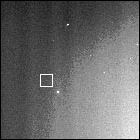 Mere weeks after entering orbit around the huge ringed planet, the Cassini is already making impressive discoveries at Saturn. NASA announces that Cassini images have uncovered two previously undiscovered moons in orbit of the ringed planet, and they’re among the smallest bodies that have yet been detected in space, each barely 2 miles in diameter. They’re given the provisional names s/2004 S1 and s/2004 S2, and await further verification of their size and orbits – and undoubtedly other members of Saturn’s family are waiting to be captured by Cassini’s cameras in the course of its planned four-year survey of the planet and its moons.
Mere weeks after entering orbit around the huge ringed planet, the Cassini is already making impressive discoveries at Saturn. NASA announces that Cassini images have uncovered two previously undiscovered moons in orbit of the ringed planet, and they’re among the smallest bodies that have yet been detected in space, each barely 2 miles in diameter. They’re given the provisional names s/2004 S1 and s/2004 S2, and await further verification of their size and orbits – and undoubtedly other members of Saturn’s family are waiting to be captured by Cassini’s cameras in the course of its planned four-year survey of the planet and its moons.
Cassini arrives at Saturn
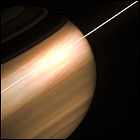 After a journey of seven years, gravity-assist slingshots past Earth, Venus and Jupiter, a plunge through Saturn’s ring-plane, and an engine burn of over an hour just to slow it down, the NASA/ESA space probe Cassini becomes the first man-made object to orbit Saturn. The trip has already paid off: Cassini has spotted never-before-seen features in Saturn’s immense rings, and succeeds in piercing Titan’s atmosphere with infrared imaging to provide one of the first-ever glimpses of the huge moon’s cloud-covered surface. Titan will also receive a visit from Cassini’s Huygens probe in 2005.
After a journey of seven years, gravity-assist slingshots past Earth, Venus and Jupiter, a plunge through Saturn’s ring-plane, and an engine burn of over an hour just to slow it down, the NASA/ESA space probe Cassini becomes the first man-made object to orbit Saturn. The trip has already paid off: Cassini has spotted never-before-seen features in Saturn’s immense rings, and succeeds in piercing Titan’s atmosphere with infrared imaging to provide one of the first-ever glimpses of the huge moon’s cloud-covered surface. Titan will also receive a visit from Cassini’s Huygens probe in 2005.
Cassini captures clumping
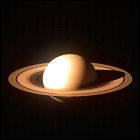 The Cassini spacecraft is close enough to Saturn to observe unusual transitory “clumps” in the planet’s ring system. First spotted by the Voyager space probes in the early 1980s, these clumps zip around Saturn’s outermost rings, following the direction of the planet’s own motion, but until now it hasn’t been possible to get close enough to study those clumps. Unlike the Voyagers, however, Cassini won’t be zipping past the planet at the speed of a bullet – it will enter an orbit around the planet in July and keep an eye on things.
The Cassini spacecraft is close enough to Saturn to observe unusual transitory “clumps” in the planet’s ring system. First spotted by the Voyager space probes in the early 1980s, these clumps zip around Saturn’s outermost rings, following the direction of the planet’s own motion, but until now it hasn’t been possible to get close enough to study those clumps. Unlike the Voyagers, however, Cassini won’t be zipping past the planet at the speed of a bullet – it will enter an orbit around the planet in July and keep an eye on things.
Hello, Himalia!
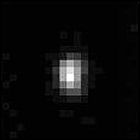 NASA releases a photo taken by the Cassini space probe as it passed by Jupiter and its complex system of satellites in December 2000, showing the first-ever view of the tiny moon Himalia, taken from a distance of 2.7 million miles. Non-spherical in shape, but estimated to be roughly 100 miles across its widest face, Himalia is believed to be an asteroid permanently captured into an inclined orbit of Jupiter. It was discovered in 1904 from Earth-based telescopes. The New Horizons space probe will also attempt to image Himalia in 2007. The sixth largest satellite of Jupiter, Himalia is the first of the planet’s outer satellites beyond the orbit of Callisto to be photographed by a passing spacecraft.
NASA releases a photo taken by the Cassini space probe as it passed by Jupiter and its complex system of satellites in December 2000, showing the first-ever view of the tiny moon Himalia, taken from a distance of 2.7 million miles. Non-spherical in shape, but estimated to be roughly 100 miles across its widest face, Himalia is believed to be an asteroid permanently captured into an inclined orbit of Jupiter. It was discovered in 1904 from Earth-based telescopes. The New Horizons space probe will also attempt to image Himalia in 2007. The sixth largest satellite of Jupiter, Himalia is the first of the planet’s outer satellites beyond the orbit of Callisto to be photographed by a passing spacecraft.
Cassini swings by Jupiter
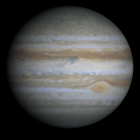 NASA’s Cassini space probe successfully completes a slingshot maneuver past Jupiter, a necessary milestone on the unmanned robot’s long journey to Saturn. While in the neighborhood, Cassini conducts tandem studies of Jupiter with the still-operational Galileo probe, which – despite numerous major malfunctions – has still survived three years longer in Jovian space than it was expected to. As large as Jupiter is, Cassini will still be lending its electronic eyes and ears to studies of the largest planet well into January. Cassini will reach Saturn’s neighborhood in 2004.
NASA’s Cassini space probe successfully completes a slingshot maneuver past Jupiter, a necessary milestone on the unmanned robot’s long journey to Saturn. While in the neighborhood, Cassini conducts tandem studies of Jupiter with the still-operational Galileo probe, which – despite numerous major malfunctions – has still survived three years longer in Jovian space than it was expected to. As large as Jupiter is, Cassini will still be lending its electronic eyes and ears to studies of the largest planet well into January. Cassini will reach Saturn’s neighborhood in 2004.
Cassini launched
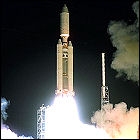 NASA/JPL’s interplanetary probe Cassini, with the European Space Agency-built Huygens Titan probe tagging along, lifts off on a Titan IV-B rocket. The voyage to Saturn will last seven years, during which Cassini does close flybys to receive gravity assists from Venus, Earth, Earth’s moon, and Jupiter en route to Saturn. It will operate in Saturn’s vicinity for over a decade and launch the Huygens probe, the first landing probe to visit a body in the outer solar system.
NASA/JPL’s interplanetary probe Cassini, with the European Space Agency-built Huygens Titan probe tagging along, lifts off on a Titan IV-B rocket. The voyage to Saturn will last seven years, during which Cassini does close flybys to receive gravity assists from Venus, Earth, Earth’s moon, and Jupiter en route to Saturn. It will operate in Saturn’s vicinity for over a decade and launch the Huygens probe, the first landing probe to visit a body in the outer solar system.